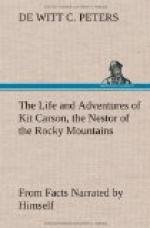The day following the one on which the fight had taken place, Kit Carson returned from Santa Fe and passed near to the spot where the soldiers had been so roughly handled; but he did not see a visage of an Apache. They had, by that time, traveled to the west side of the Rio del Norte. Indeed, he anticipated no danger to himself, as he was well aware, that the safest time to travel through any section of an Indian country, is just after the savages have been guilty of some highhanded act. They are then, instinctively, as some may say, but, as the fact appears to us, by use of their reasoning powers, well aware that active measures will be set on foot to repay them for their rascality.
The trail which, on this occasion, Kit Carson traveled over in coming from Santa Fe, is one of the most interesting routes, in safe times, that the mere traveler can select. It comprises some of the most beautiful scenery in New Mexico. The length of the trail is about seventy-five miles, and so many windings and turns does it make through mountains, forests and gorges, that every hundred yards furnishes a suitable place for an Indian ambuscade. The largest part of the country which lies between Taos and Santa Fe, is mountainous; therefore, this trail is one series of ascents and descents. The greatest pitch is near the scene of the fight in which Lieutenant Davidson and his command were engaged, where the path, in order to avoid an almost perpendicular declivity, makes a zig zag course. To accomplish the ascent of this mountain on a good riding animal, it takes, at least, two hours; therefore, the height of the mountain can be easily imagined by those accustomed to mountain climbing. On reaching some of these immense eminences, the scenery is principally formed by the broken country, studded here and there with mountains, which appear as if in miniature, as well as real. Between are




